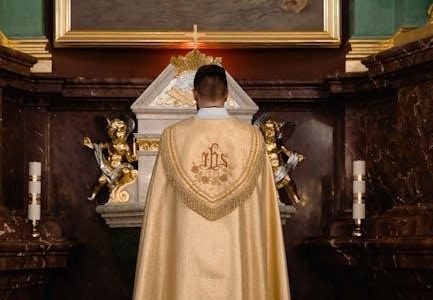The Tabernacle Prayer Guide offers a structured approach to deepen your prayer life, drawing inspiration from the biblical Tabernacle’s design and symbolism. Each section represents a step closer to God’s presence, guiding believers through praise, repentance, and intimate fellowship. This model bridges ancient worship practices with modern spiritual devotion, helping individuals experience God’s presence and redemption in a meaningful way.

Understanding the Tabernacle’s Historical and Spiritual Significance
The Tabernacle, a portable place of worship for the Israelites, holds profound historical and spiritual significance. It was a physical representation of God’s desire to dwell among His people, serving as a sacred space for worship, sacrifice, and divine encounters. Historically, it symbolized God’s presence and covenant with Israel, while spiritually, it foreshadowed redemption through Jesus Christ. The Tabernacle’s design and rituals, such as the altar of burnt offering and the most holy place, were intentional, teaching believers about sin, atonement, and intimacy with God. Its structure and practices laid the foundation for New Testament worship, emphasizing access to God through Christ. Today, the Tabernacle serves as a powerful model for prayer, guiding believers to encounter God’s presence and experience spiritual transformation. Its timeless lessons continue to inspire devotion, connecting ancient traditions with modern faith practices.
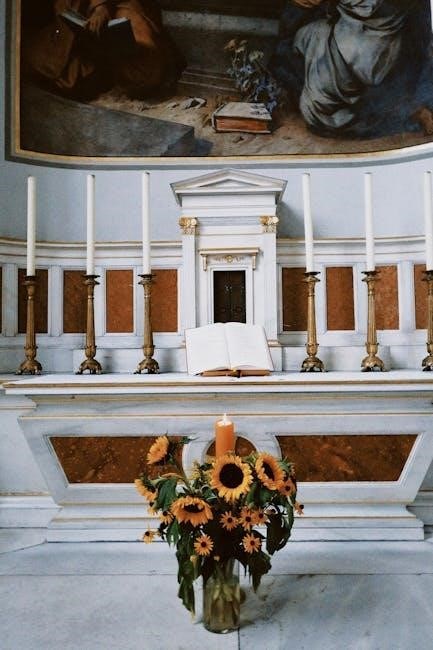
How the Tabernacle Serves as a Model for Prayer
The Tabernacle provides a profound model for prayer, guiding believers through a structured and intentional approach to connecting with God. Its design symbolizes a journey into God’s presence, from the outer court to the most holy place. Each section of the Tabernacle represents a step in prayer: praise at the gate, confession at the altar, cleansing at the laver, intercession in the holy place, and intimate fellowship in the most holy place. This progression reflects the deepening of prayer life, from initial thanksgiving to a place of surrender and communion. The Tabernacle’s structure emphasizes the importance of preparation, humility, and reverence in prayer. By following this model, believers can experience a meaningful and transformative prayer life, drawing closer to God’s heart. This ancient worship pattern continues to inspire modern prayer practices, offering a pathway to encounter God’s presence and grace. The Tabernacle’s principles remain timeless, bridging history and contemporary devotion.
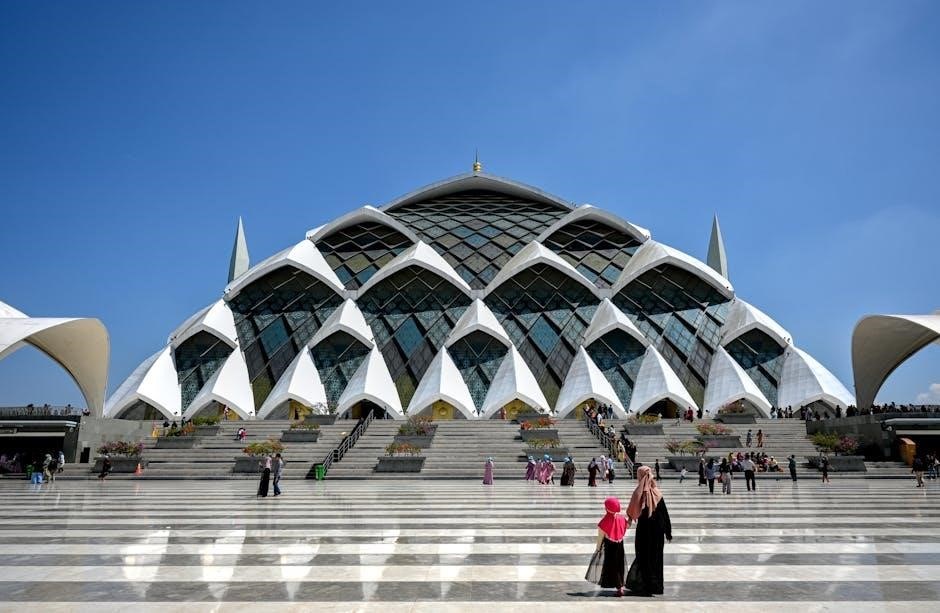
Structure of the Tabernacle
The Tabernacle consists of the Gate, Altar of Burnt Offering, Laver, Holy Place, and Most Holy Place, each serving a distinct purpose in worship and divine encounter.
The Gate: The Entrance to God’s Presence
The Gate symbolizes the starting point of the spiritual journey, representing access to God’s presence; It signifies humility and surrender, inviting believers to enter with reverence and praise. Historically, the Gate was the only entrance to the Tabernacle, emphasizing unity and singleness of purpose. In prayer, it teaches us to begin by acknowledging God’s majesty and expressing gratitude. This step fosters a heart of worship, preparing believers to draw near to God. By focusing on praise and thanksgiving at the Gate, we align our hearts with God’s, creating a foundation for deeper fellowship. The Gate reminds us that prayer is not just a ritual but a sacred encounter, requiring mindfulness and devotion. It encourages believers to leave worldly concerns behind and focus on God’s holiness and love. This initial step in the Tabernacle prayer guide sets the tone for a meaningful and transformative prayer experience.
The Altar of Burnt Offering: Sacrifice and Atonement
The Altar of Burnt Offering was the first stop after entering the Tabernacle, symbolizing sacrifice and atonement. It represented the shedding of blood, a powerful symbol of redemption and forgiveness. In prayer, this step encourages believers to confess their sins and repent, acknowledging Jesus Christ as the ultimate sacrifice for humanity. The Altar reminds us that prayer must begin with a humble heart, recognizing our need for cleansing and forgiveness. By reflecting on the sacrifices of the past, we align our prayers with the sacrificial love of Christ, who paid the ultimate price for our sins. This step in the Tabernacle prayer guide invites believers to seek purification and renewed fellowship with God, laying a spiritual foundation for deeper prayer and intimacy with Him.
The Laver: Cleansing and Preparation for Prayer
The Laver, a basin of water, symbolized purification and spiritual cleansing for the priests before entering the Holy Place. In prayer, it represents the believer’s need to examine their heart and mind, seeking purity before God. This step in the Tabernacle Prayer Guide reminds us that prayer is not just about speaking but also about preparation. Just as the priests washed physically, believers must cleanse themselves spiritually through confession and repentance. The Laver teaches us to approach God with humility and self-awareness, recognizing that true prayer begins with a clean heart; By reflecting on this symbol, we are encouraged to purify our thoughts and intentions, aligning our prayers with God’s holiness and preparing ourselves to enter His presence deeply and sincerely.
The Tabernacle Heart: The Holy Place and the Most Holy Place
The Holy Place and the Most Holy Place formed the inner sanctum of the Tabernacle, symbolizing the deepest levels of intimacy with God. The Holy Place contained the menorah, table of showbread, and altar of incense, representing God’s light, provision, and prayer ascending to Him. These elements emphasize the importance of living a life of worship, thanksgiving, and continuous prayer. The Most Holy Place, housing the Ark of the Covenant, was the very presence of God, accessible only to the high priest once a year. This sacred space signifies the ultimate goal of prayer: intimate fellowship with God. Together, these chambers remind believers that prayer is a journey from outward acts of worship to inner communion with the Divine, culminating in rest and surrender in God’s presence.
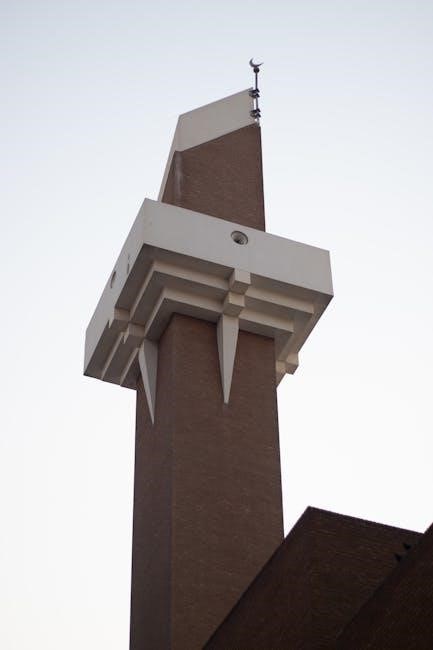
Prayer Guide Through the Tabernacle
The Tabernacle Prayer Guide provides a structured approach to prayer, guiding believers through the Gate, Altar, Laver, and Holy and Most Holy Places, symbolizing a journey from praise to intimate fellowship with God.

Praise and Thanksgiving at the Gate
The Gate symbolizes the entrance into God’s presence, marking the beginning of a prayer journey. It represents the threshold where believers transition from the world to a sacred space of worship. Here, praise and thanksgiving set the tone for prayer, acknowledging God’s sovereignty and grace. By focusing on His goodness and blessings, individuals align their hearts with a spirit of gratitude. This step mirrors the Israelites’ practice of entering the Tabernacle with offerings of praise, expressing reverence and joy. In modern prayer, starting at the Gate encourages believers to reflect on God’s faithfulness, creating a humble and thankful posture before Him. This foundational step prepares the heart for deeper communion and intercession, reminding us that prayer is not just a request but a celebration of God’s character and works.
Confession and Repentance at the Altar
The Altar of Burnt Offering symbolizes sacrifice and atonement, serving as a powerful reminder of the need for confession and repentance in prayer; Just as the Israelites offered sacrifices to atone for their sins, believers today can use this step to acknowledge their shortcomings before God. Confession involves openly admitting sins, while repentance is a commitment to turn away from them. This process cleanses the heart, preparing it for deeper communion with God. The Altar represents the cross of Jesus Christ, where the ultimate sacrifice was made for humanity’s redemption. By embracing this step, believers align their prayers with God’s desire for holiness and restoration. Through confession and repentance, individuals experience spiritual cleansing, paving the way for a more intimate and effective prayer life. This foundational step ensures that prayer is rooted in humility and a sincere desire to walk in God’s will.
Sanctification and Cleansing at the Laver
The Laver, a basin of water, symbolized purification and spiritual cleansing for the priests before entering the Holy Place. In the Tabernacle Prayer Guide, this step represents believers’ need to sanctify themselves, preparing their hearts and minds for deeper prayer. Just as the priests washed physically, believers are called to cleanse themselves spiritually, acknowledging their imperfections and seeking God’s purification. This step involves self-reflection, confessing any lingering sins, and asking the Holy Spirit to cleanse and renew their inner being. The Laver reminds us that true prayer begins with humility and a willingness to be set apart for God’s purposes. By embracing this step, believers align themselves with God’s holiness, enabling them to approach Him with sincerity and intimacy. Sanctification at the Laver is not a one-time event but a continuous process of surrender and transformation, empowering believers to live a life pleasing to God.
Intercession in the Holy Place
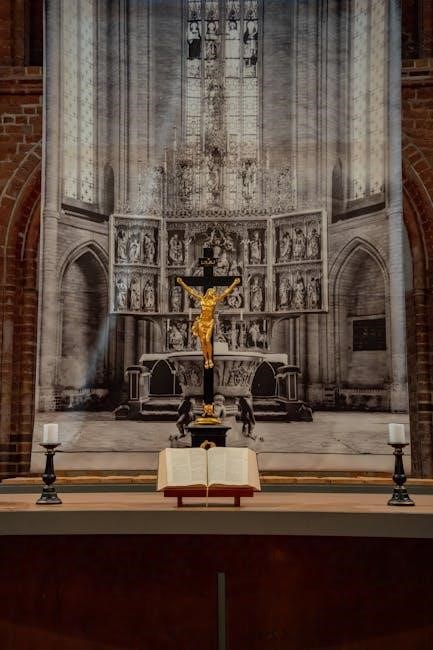
Entering the Holy Place in the Tabernacle Prayer Guide signifies a deeper level of communion with God, where believers transition from personal cleansing to interceding for others. This sacred space, once reserved for priests, now invites all believers to pray on behalf of others, mirroring Christ’s role as our eternal Intercessor. The Holy Place emphasizes the importance of praying for the church, family, and community, seeking God’s will and intervention in their lives. The golden altar of incense, symbolizing ascending prayers, reminds us that intercession is a powerful act of spiritual warfare and love; Through this step, believers align their hearts with God’s desires, pleading for His mercy, healing, and guidance. The Holy Spirit guides and empowers these prayers, ensuring they align with God’s plan. Intercession in the Holy Place is not just a duty but a privilege, fostering unity and advancing God’s kingdom on earth.
Intimate Fellowship in the Most Holy Place
The Most Holy Place represents the pinnacle of divine encounter, where believers experience intimate fellowship with God. This sacred space, once accessible only to the high priest, now symbolizes direct communion with God through Jesus Christ. The Ark of the Covenant, with its mercy seat, reminds us of God’s throne of grace, where we can boldly approach Him. In this deepest part of the Tabernacle Prayer Guide, believers enter into a personal, transformative relationship with God, unencumbered by formalities. The Holy Spirit facilitates this fellowship, enabling believers to commune with God in silence, worship, and surrender. This intimate connection fosters a deeper understanding of God’s love and will, empowering believers to live a life pleasing to Him. The Most Holy Place is not just a physical location but a spiritual reality, where believers find rest, renewal, and a profound sense of God’s presence.

Spiritual Journey Through the Tabernacle
The Tabernacle prayer guide leads believers on a spiritual journey from the Gate to the Most Holy Place, symbolizing progression in prayer, intimacy, and divine encounter. Each step reflects deeper communion with God, guided by the Holy Spirit, fostering transformation and fellowship.
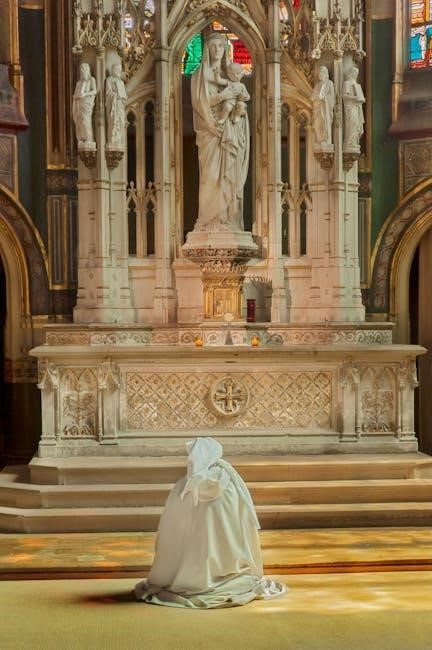
Progression in Prayer: From the Gate to the Most Holy Place
The Tabernacle Prayer Guide illustrates a progressive journey in prayer, beginning at the Gate and culminating in the Most Holy Place. This structured approach mirrors the ancient Tabernacle’s layout, where each station symbolizes a deeper level of spiritual engagement. At the Gate, believers start with praise and thanksgiving, acknowledging God’s presence. Moving to the Altar of Burnt Offering, they engage in confession and repentance, reflecting on Christ’s sacrifice. The Laver represents cleansing and preparation for deeper communion. Entering the Holy Place, intercession and worship take precedence, followed by the Most Holy Place, where intimate fellowship with God is experienced. This progression mirrors the believer’s spiritual growth, from initial acknowledgment to profound intimacy, guided by the Holy Spirit and rooted in biblical principles. Through this model, prayer becomes a transformative journey, drawing believers closer to God’s heart.
The Role of the Holy Spirit in Guiding Prayer
The Holy Spirit plays a vital role in guiding prayer through the Tabernacle model, empowering believers to connect deeply with God. He illuminates each station’s significance, from the Gate to the Most Holy Place, ensuring prayers align with God’s will. At the Gate, the Spirit stirs hearts to praise and thanksgiving. At the Altar, He convicts of sin, enabling genuine repentance. The Laver represents His cleansing work, sanctifying believers for deeper communion. In the Holy Place, the Spirit intercedes, helping believers pray beyond their limitations. Finally, in the Most Holy Place, He facilitates intimate fellowship, revealing God’s heart and transforming the believer. Through the Tabernacle Prayer Guide, the Holy Spirit guides each step, ensuring prayer becomes a powerful, Spirit-led encounter that draws believers closer to God.
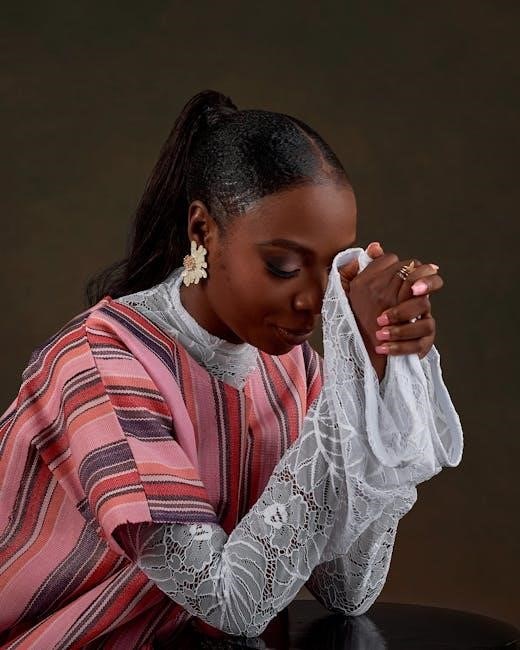
Modern Application of the Tabernacle Prayer Model
The Tabernacle Prayer Model offers a timeless structure for modern prayer, providing a clear path to deepen spiritual connection. Its simplicity and accessibility make it a powerful daily guide for believers.
Using the Tabernacle as a Daily Prayer Guide
The Tabernacle Prayer Guide provides a transformative daily prayer structure, rooted in biblical symbolism. Each section of the Tabernacle—Gate, Altar, Laver, Holy Place, and Most Holy Place—offers a step-by-step approach to deepen prayer. Begin with praise and thanksgiving at the Gate, acknowledging God’s presence. Move to confession and repentance at the Altar, reflecting on spiritual cleansing. At the Laver, focus on sanctification, preparing your heart for deeper communion. In the Holy Place, engage in intercession, praying for others and divine guidance. Finally, enter the Most Holy Place for intimate fellowship, seeking God’s will and empowerment. This model ensures a balanced and intentional prayer life, helping believers connect with God’s presence daily. It serves as a practical tool to organize and enrich personal devotion, fostering a deeper spiritual journey and intimacy with Christ.
Overcoming Challenges in Prayer Through Tabernacle Principles
The Tabernacle Prayer Guide equips believers to overcome prayer challenges by aligning their devotion with biblical principles. Many struggle with feeling disconnected or uncertain in prayer, but the Tabernacle’s structure offers clarity. Begin by entering God’s presence with praise at the Gate, fostering gratitude and mindfulness. At the Altar, address sin and repentance, allowing spiritual cleansing to deepen your connection. The Laver reminds us to prepare our hearts, ensuring purity and focus in prayer. In the Holy Place, intercession and worship guide us to pray for others and seek divine guidance; Finally, the Most Holy Place invites intimate fellowship, helping believers overcome feelings of distance. By following this model, prayer becomes structured, intentional, and transformative, enabling believers to break through prayer barriers and experience God’s presence more fully. This approach ensures prayer remains vibrant, purposeful, and aligned with God’s heart.

